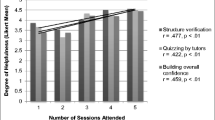Abstract
An increasing number of medical institutions across the USA are now utilizing a prosection-based approach to teach human anatomy. This practice enables students to make use of specimens on a more flexible schedule, which has sparked demand for additional practice identifying structures and relating concepts. In order to accommodate this demand, we have developed an anatomy teaching assistant (TA) program in which second-year medical students (MS2s) act as tutors for their first-year peers (MS1s). MS2s are selected as TAs on the basis of prior anatomy examination performance, teaching experience, and other criteria. At least once per week, for 2 h, they provide focused review of human anatomy to MS1 peers. Anatomy faculty and staff provide core instruction and support throughout. The program has received overwhelmingly positive evaluations and comments from students. MS1 students, using a modified Likert scale, reported that multiple specific techniques used by TAs were helpful. MS1s also reported overall improvement in their confidence as a result of the sessions. Correlation analyses demonstrated positive associations between utility reported by a given student and the number of sessions that student attended. MS2s also reported improved test and clinical performance as a result of the program. Peer tutoring programs enhance learning across multiple domains in medical education, including gross anatomy. Strategies for implementation of such a program are presented here. It is our belief that other institutions could benefit from establishment of analogous programs.
Similar content being viewed by others
References
Dinsmore CE, Daugherty S, Zeitz HJ. Teaching and learning gross anatomy: dissection, prosection, or “both of the above?”. Clin Anat. 1999;12(2):110–4.
Winkelmann A. Anatomical dissection as a teaching method in medical school: a review of the evidence. Med Educ. 2007;41(1):15–22.
Drake RL, McBride JM, Pawlina W. An update on the status of anatomical sciences education in United States medical schools. Anat Sci Educ. 2014;7(4):321–5.
Gabard DL, Lowe DL, Chang JW. Current and future instructional methods and influencing factors in anatomy instruction in physical therapy and medical schools in the U.S. J Allied Health Summer 2012;41(2):53–62.
Davis CR, Bates AS, Ellis H, Roberts AM. Human anatomy: let the students tell us how to teach. Anat Sci Educ. 2014;7(4):262–72.
Sugand K, Abrahams P, Khurana A. The anatomy of anatomy: a review for its modernization. Anat Sci Educ. 2010;3(2):83–93.
McMenamin PG, Quayle MR, McHenry CR, Adams JW. The production of anatomical teaching resources using three-dimensional (3D) printing technology. Anat Sci Educ. 2014;7(6):479–86.
Walker-Bartnick LA, Berger JH, Kappelman MM. A model for peer tutoring in the medical school setting. J Med Educ. 1984;59(4):309–15.
Moorewest M, Hennessy SA, Meilman PW, Odonnell JF. The presence of student-based peer advising, peer tutoring, and performance evaluation programs among U.S. medical schools. Acad Med. 1990;65(10):660–1.
Sobral DT. Cross-year peer tutoring experience in a medical school: conditions and outcomes for student tutors. Med Educ. 2002;36(11):1064–70.
Hurley KF, McKay DW, Scott TM, James BM. The supplemental instruction project: peer-devised and delivered tutorials. Med Teach. 2003;25(4):404–7.
Nestel D, Kidd J. Peer tutoring in patient-centred interviewing skills: experience of a project for first-year students. Med Teach. 2003;25(4):398–403.
Santee J, Garavalia L. Peer tutoring programs in health professions schools. Am J Pharm Educ. 2006;70(3):70.
Buckley S, Zamora J. Effects of participation in a cross year peer tutoring programme in clinical examination skills on volunteer tutors’ skills and attitudes towards teachers and teaching. BMC Med Educ. 2007;7:20.
Barnes HV, Albanese M, Schroeder J, Reiter S. Senior medical students teaching the basic skills of history and physical examination. J Med Educ. 1978;53(5):432–4.
Escovitz ES. Using senior students as clinical skills teaching assistants. Acad Med. 1990;65(12):733–4.
Haist SA, Wilson JF, Fosson SE, Brigham NL. Are fourth-year medical students effective teachers of the physical examination to first-year medical students? J Gen Intern Med. 1997;12(3):177–81.
Field M, Burke JM, McAllister D, Lloyd DM. Peer-assisted learning: a novel approach to clinical skills learning for medical students. Med Educ. 2007;41(4):411–8.
Trevino FM, Eiland DC Jr. Evaluation of a basic science, peer tutorial program for first- and second-year medical students. J Med Educ. 1980;55(11):952–3.
Krych AJ, March CN, Bryan RE, Peake BJ, Pawlina W, Carmichael SW. Reciprocal peer teaching: students teaching students in the gross anatomy laboratory. Clin Anat. 2005;18(4):296–301.
Escovedo C, Harrison D, Lentz J, Schmalz NA, Stahl L, Thakur S, et al. Utility and efficacy of a peer-based anatomy tutoring program for first year medical students. Med Sci Educ. 2016;26(1):105–9.
Harrison D, Lentz J, Schmalz NA, Escovedo C, Stark E. Peer-based anatomy tutoring for first-year medical students: an analysis of peer-tutoring from the tutors’ perspective. Med Sci Educ. 2017;27(1):57–61.
Schmalz NA, Escovedo C, Harrison D, Lentz J, Stahl L, Thakur S, Parker N, Stark E. A longitudinal study of the utility and efficacy of a peer-based anatomy tutoring program for first-year medical students: 2011–2015 [Abstract 565.3]. FASEB J. 2016;30.
Funding
The funding for SurveyMonkey accounts, AppointmentPlus accounts, and tutor payments (2011–2015) came from the Office of the Dean, in the David Geffen School of Medicine at UCLA.
Author information
Authors and Affiliations
Corresponding author
Ethics declarations
Conflict of Interest
The authors declare that they have no conflict of interest.
Rights and permissions
About this article
Cite this article
Christensen, J.D., Schmalz, N.A., Challyandra, L. et al. Establishment of a Peer Teaching Assistant Program for Preclinical Human Gross Anatomy Curricula. Med.Sci.Educ. 28, 765–772 (2018). https://doi.org/10.1007/s40670-018-0604-8
Published:
Issue Date:
DOI: https://doi.org/10.1007/s40670-018-0604-8




